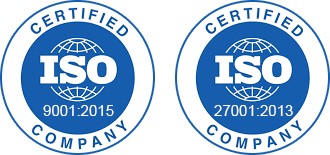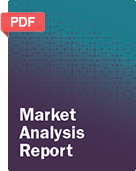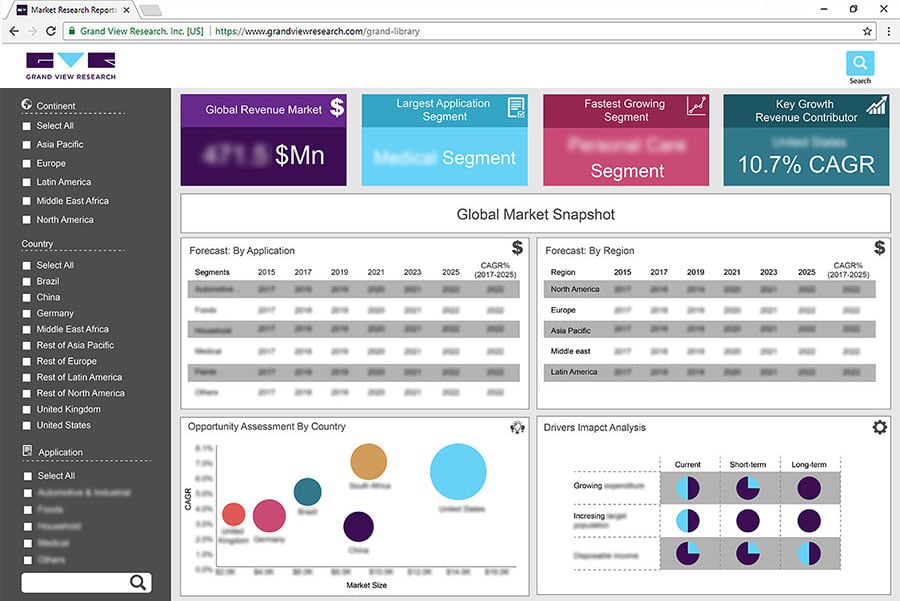- Home
- »
- Advanced Interior Materials
- »
-
Asia Pacific Reflective Materials Market Size, Industry Report, 2025GVR Report cover
![Asia Pacific Reflective Materials Market Size, Share & Trends Report]()
Asia Pacific Reflective Materials Market Size, Share & Trends Analysis Report By Product (Tapes & Films, Paints & Inks), By End Use (Textile, Construction & Roads), By Application, And Segment Forecasts, 2019 - 2025
- Report ID: GVR-4-68038-122-1
- Number of Report Pages: 113
- Format: PDF, Horizon Databook
- Historical Range: 2014 - 2017
- Forecast Period: 2019 - 2025
- Industry: Advanced Materials
Industry Insights
The Asia Pacific reflective materials market size was estimated at USD 1.54 billion in 2018 and is expected to expand at a CAGR of 6.1% from 2019 to 2025. The market is expected to be driven by increasing awareness regarding workplace safety and traffic safety management. The manufacturers have a broad supplier base. These companies try to procure raw materials from the local vendors to the maximum extent possible. However, in countries such as Sri Lanka and Cambodia, the specialty raw materials are required to be imported due to a lack of local suppliers.
The automotive industry in China is projected to witness growth owing to the rising number of government initiatives undertaken to maximize the automobile output by 2025. Growing concerns related to vehicle safety is likely to result in increased adoption of these products, such as tapes, paints, coatings, and other such products.
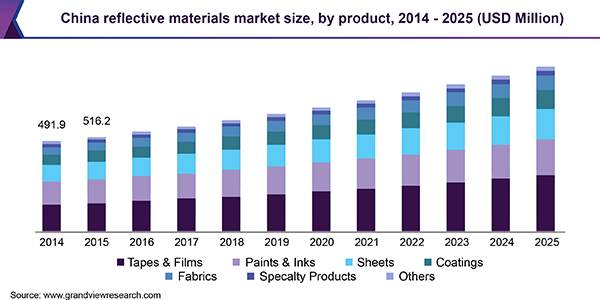
The products are characterized by a low degree of absorption coefficient and a high degree of reflectivity. Retro-reflective elements, including glass beads and micro prisms, are the most popularly used products for road applications, owing to their flexibility, impact resistance, durability, and a coefficient of retro-reflective range of angles.
The SWICOFIL Company has industrialized a retro-reflective form of technology from raw materials, including micro prisms and glass beads, which is established by the utilization of glass beads and micro prisms and reflect the light falling on them back to its source. Also, 3M has commercialized the C790 technology to cater to the advanced demand of the reflective apparel market.
The Asia Pacific reflective materials industry participants are expected to face challenges due to strict guidelines for the selection of retro-reflective sheeting for traffic signage. Government agencies, such as OSHA, NIOSH, and TCSA regulate the use of metals and proper disposal of substrate materials. The legal implications include the proper production process along with environment-friendly products.
Product Insights
The demand for reflective fabric is projected to witness a CAGR of 6.6% over the forecast period owing to its increasing use in the textile industry for the production of sportswear, vest, poncho, and others. The product is widely used in the production of protective clothing, which is used by cyclists, traffic controllers, and construction workers, among others.
The demand for reflective tapes and films is projected to witness growth in the Asia Pacific owing to the stringent road safety rules implemented by the government. These tapes and films increase the visibility of the vehicle, thereby minimizing the risk of accidents. Besides, their increasing usage in road markings and caution symbols to manage traffic is expected to bode well for the overall demand.
Reflective sheets are estimated to reach USD 428.1 million by 2025, owing to their rising adoption in traffic signboards, gift wraps, lamps, advertising materials, decorative materials, and solar reflective panels. These sheets are also used in packaging materials to enhance the aesthetic features of the packed product thereby driving the demand.
Reflective paints are increasingly used in manufacturing and production industries to highlight caution signs as well as chemical containers to avoid industrial accidents. Expansion of the industrial sector in the Asia Pacific is projected to witness growth over the forecast period thereby boosting the product demand to ensure industrial safety.
Application Insights
The demand for reflective materials in the textile industry is projected to witness rise at a CAGR of 5.9% from 2019 to 2025, owing to the implementation of stringent government norms concerning the minimization of workplace-related accidents over the forecast period. Rising concerns related to employee safety at the workplace are considered to drive the growth.
Increasing construction and infrastructural activities in the Asia Pacific are projected to promote the adoption of reflective materials in the construction and road application. The demand for reflective paints and coatings and tapes and films is anticipated to witness a rise in construction sites, roadways, and highways owing to high visibility offered by these products.
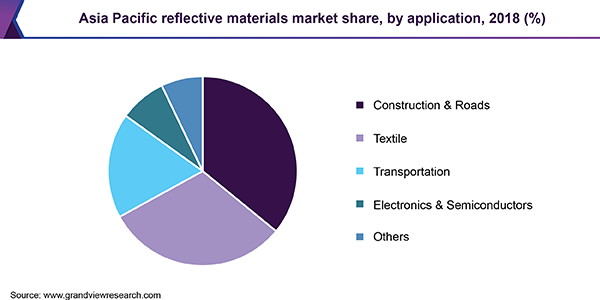
The transportation industry is projected to account for 20.11% of market share in 2018 owing to the increasing use of reflective materials such as tapes, paints, stickers, coatings, and others to improve aesthetic features of the vehicle and to provide safety. Growing awareness regarding product benefits is likely to boost growth over the forecast period.
The electronics and semiconductor industry is projected to witness significant growth over the forecast period owing to the rising use of reflective materials in the safety equipment and electronic device sensors. Reflection of incident light to activate the sensor plays a major role in many electronic devices in providing safety, and smooth product functioning thereby driving the use of reflective materials.
Regional Insights
China dominated the Asia Pacific reflective materials market, accounting for a revenue of USD 606.8 million in 2018 and is expected to continue to lead the industry over the forecast period. Rising automotive production, coupled with growing concerns related to vehicle safety is likely to result in increased product adoption in the country over the forecast period.
Rise in the number of construction sites and manufacturing units in India is anticipated to propel the demand for various reflective materials-based products, including jackets, vests, helmets, signboards, and road pavement markings in the country. These products help increase the visibility of the wearer or the object and help prevent accidents. This factor is likely to propel growth.
Indonesia is expected to witness the fastest CAGR of 8.1% over the forecast period, attributed to the rising adoption of reflective clothing in construction and infrastructure, coupled with growth in residential and commercial construction activities. Also, the expansion of automotive production capacity in the country is expected to aid market growth.
Rapid urbanization and the rising number of infrastructural projects undertaken by the government of Bangladesh is projected to drive the demand for reflective materials in the country. Automotive manufacturers and assemblers operating in the country are increasingly employing such tapes to improve the visibility of vehicles and avoid accidents, which is predicted to boost the market growth over the forecast period.
Asia Pacific Reflective Materials Market Share Insights
The market exhibits intense competition, owing to the presence of established players as well as local players. Industry participants compete based on market goodwill, product quality, technological advancements, and distribution network. Most companies focus on mergers and acquisitions to expand their product portfolio as well as geographical footprint.
The market players prioritize portfolio management through strategic acquisitions and divestitures. Since product innovation helps prevent price-based competition, a majority of the companies emphasize building their technological capabilities to improve their product development capacity.
Report Scope
Attribute
Details
The base year for estimation
2018
Actual estimates/Historical data
2014 - 2017
Forecast period
2019 - 2025
Market representation
Revenue in USD Million and CAGR from 2019 to 2025
Regional scope
Asia Pacific
Country scope
China, India, Indonesia, Sri Lanka, Bangladesh, Cambodia, Vietnam
Report coverage
Revenue forecast, competitive landscape, growth factors and trends
15% free customization scope (equivalent to 5 analysts working days)
If you need specific information, which is not currently within the scope of the report, we will provide it to you as a part of customization
Segments Covered in the ReportThis report forecasts revenue growth at regional and country levels and provides an analysis of the latest industry trends in each of the sub-segments from 2014 to 2025. For this study, Grand View Research has segmented the Asia Pacific reflective materials market report based on product, application, and country:
-
Product Outlook (Revenue, USD Million; 2014 - 2025)
-
Fabric
-
Sheets
-
Paints & Inks
-
Tapes & Films
-
Coatings
-
Specialty Products
-
Others
-
-
Application Outlook (Revenue, USD Million; 2014 - 2025)
-
Textile
-
Construction & Roads
-
Transportation
-
Electronics & Semiconductors
-
Others
-
-
Regional Outlook (Revenue, USD Million; 2014 - 2025)
-
China
-
India
-
Indonesia
-
Sri Lanka
-
Bangladesh
-
Cambodia
-
Vietnam
-
Share this report with your colleague or friend.
![gvr icn]()
NEED A CUSTOM REPORT?
We can customize every report - free of charge - including purchasing stand-alone sections or country-level reports, as well as offer affordable discounts for start-ups & universities. Contact us now
![Certified Icon]()
We are GDPR and CCPA compliant! Your transaction & personal information is safe and secure. For more details, please read our privacy policy.
We are committed towards customer satisfaction, and quality service.
"The quality of research they have done for us has been excellent."
